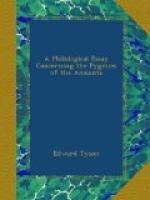[Footnote A: Folk Tales of the Magyars, p. xxix.]
(6.) Tales of little people are to be found in countries where there never were any Pigmy races. Not to deal with other, and perhaps more debatable districts, we find an excellent example of this in North America. Besides the instances mentioned in the foregoing section, the following may be mentioned. Mr. Leland, speaking of the Un-a-games-suk, or Indian spirits of the rocks and streams, says that these beings enter far more largely, deeply, and socially into the life and faith of the Indians than elves or fairies ever did into those of the Aryan race.[A] In his Algonquin Legends the same author also alludes to small people.
[Footnote A: Memoirs, i. 34.]
Dr. Brinton tells me that the Micmacs have tales of similar Pigmies, whom they call Wig[)u]l[)a]d[)u]mooch, who tie people with cords during their sleep, &c. Mr. L.L. Frost, of Susanville, Lassen County, California, tells us how, when he requested an Indian to gather and bring in all the arrow-points he could find, the Indian declared them to be “no good,” that they had been made by the lizards. Whereupon Mr. Frost drew from him the following lizard-story. “There was a time when the lizards were little men, and the arrow-points which are now found were shot by them at the grizzly bear. The bears could talk then, and would eat the little men whenever they could catch them. The arrows of the little men were so small that they would not kill the bears when shot into them, and only served to enrage them.” The Indian could not tell how the little men became transformed into lizards.[A] Again, the Shoshones of California dread their infants being changed by Ninumbees or dwarfs.[B]
[Footnote A: Folk Lore Journal, vii. 24.]
[Footnote B: Hartland, ut supra, p. 351.]
Finally, every one has read about the Pukwudjies, “the envious little people, the fairies, the pigmies,” in the pages of Longfellow’s “Hiawatha."[A] It ought to be mentioned that Mr. Leland states that the red-capped, scanty-shirted elf of the Algonquins was obtained from the Norsemen; but if, as he says, the idea of little people has sunk so deeply into the Indian mind, it cannot in any large measure have been derived from this source.[B]
[Footnote A: xviii.]
[Footnote B: Etrusco Roman Remains, p. 162.]
(7.) The stunted races whom Mr. MacRitchie considers to have formed the subjects of the fairy legend have themselves tales of little people. This is true especially of the Eskimo, as will have been already noticed, a fact to which my attention was called by Mr. Hartland.




